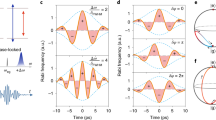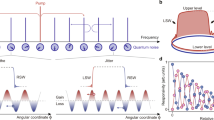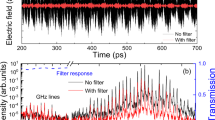Abstract
It is an important challenge to reduce the power consumption and size of lasers, but progress has been impeded by quantum noise overwhelming the coherent radiation at reduced power levels. Thus, despite considerable progress in microscale and nanoscale lasers, such as photonic crystal lasers, metallic lasers and plasmonic lasers, the coherence length remains very limited. Here we show that a bound state in the continuum based on Fano interference can effectively quench quantum fluctuations. Although fragile in nature, this unusual state redistributes photons such that the effect of spontaneous emission is suppressed. Based on this concept, we experimentally demonstrate a microscopic laser with a linewidth that is more than 20 times smaller than existing microscopic lasers and show that further reduction by several orders of magnitude is feasible. These findings pave the way for numerous applications of microscopic lasers and point to new opportunities beyond photonics.
This is a preview of subscription content, access via your institution
Access options
Access Nature and 54 other Nature Portfolio journals
Get Nature+, our best-value online-access subscription
$29.99 / 30 days
cancel any time
Subscribe to this journal
Receive 12 print issues and online access
$209.00 per year
only $17.42 per issue
Buy this article
- Purchase on Springer Link
- Instant access to full article PDF
Prices may be subject to local taxes which are calculated during checkout




Similar content being viewed by others
Data availability
All data in this study are available within the paper and its Supplementary Information. Further source data will be made available on reasonable request.
Code availability
The code used for modelling the data is available from Y.Y. on reasonable request.
Change history
26 August 2021
A Correction to this paper has been published: https://doi.org/10.1038/s41566-021-00883-y
References
Schawlow, A. L. & Townes, C. H. Infrared and optical masers. Phys. Rev. 112, 1940 (1985).
Henry, C. Theory of the linewidth of semiconductor lasers. IEEE J. Quantum Electron. 18, 259–264 (1982).
Young, B. C., Cruz, F. C., Itano, W. M. & Bergquist, J. C. Visible lasers with subhertz linewidths. Phys. Rev. Lett. 82, 3799–3802 (1999).
Mørk, J., Tromborg, B. & Mark, J. Chaos in semiconductor lasers with optical feedback: theory and experiment. IEEE J. Quantum Electron. 28, 93–108 (1992).
Tager, A. A. & Petermann, K. High-frequency oscillations and self-mode locking in short external-cavity laser diodes. IEEE J. Quantum Electron. 30, 1553–1561 (1994).
Liang, W. et al. Ultralow noise miniature external cavity semiconductor laser. Nat. Commun. 6, 7371 (2015).
Stern, B., Ji, X., Dutt, A. & Lipson, M. Compact narrow-linewidth integrated laser based on a low-loss silicon nitride ring resonator. Opt. Lett. 42, 4541–4544 (2017).
Tran, M. A., Huang, D. & Bowers, J. E. Tutorial on narrow linewidth tunable semiconductor lasers using Si/III-V heterogeneous integration. APL Photon. 4, 111101 (2019).
Santis, C. T., Vilenchik, Y., Satyan, N., Rakuljic, G. & Yariv, A. Quantum control of phase fluctuations in semiconductor lasers. Proc. Natl Acad. Sci. USA 115, E7896–E7904 (2018).
Painter, O. et al. Two-dimensional photonic band-gap defect mode laser. Science 284, 1819–1821 (1999).
Matsuo, S. et al. High-speed ultracompact buried heterostructure photonic-crystal laser with 13 fJ of energy consumed per bit transmitted. Nat. Photon. 4, 648–654 (2010).
Wu, S. et al. Monolayer semiconductor nanocavity lasers with ultralow thresholds. Nature 520, 69–72 (2015).
Crosnier, G. et al. Hybrid indium phosphide-on-silicon nanolaser diode. Nat. Photon. 11, 297–300 (2017).
Khajavikhan, M. et al. Thresholdless nanoscale coaxial lasers. Nature 482, 204–207 (2012).
Oulton, R. F. et al. Plasmon lasers at deep subwavelength scale. Nature 461, 629–632 (2009).
Bjork, G., Karlsson, A. & Yamamoto, Y. On the linewidth of microcavity lasers. Appl. Phys. Lett. 60, 304 (1992).
Sun, C. et al. Single-chip microprocessor that communicates directly using light. Nature 528, 534–538 (2015).
Bogaerts, W. et al. Programmable photonic circuits. Nature 586, 207–216 (2020).
Ge, C. et al. External cavity laser biosensor. Lab Chip 13, 1247–1256 (2013).
Carolan, J. et al. Universal linear optics. Science 349, 711–716 (2015).
Shen, Y. et al. Deep learning with coherent nanophotonic circuits. Nat. Photon. 11, 441–446 (2017).
Song, B.-S., Noda, S., Asano, T. & Akahane, Y. Ultra-high-Q photonic double-heterostructure nanocavity. Nat. Mater. 4, 207–210 (2005).
Kim, J. et al. Narrow linewidth operation of buried-heterostructure photonic crystal nanolaser. Opt. Express 20, 11643–11651 (2012).
von Neumann, J. & Wigner, E. Über merkwürdige diskrete Eigenwerte. Phys. Z. 30, 465–467 (1929).
Hsu, C. W., Zhen, B., Stone, A. D., Joannopoulos, J. D. & Soljačić, M. Bound states in the continuum. Nat. Rev. Mater. 1, 16048 (2016).
Plotnik, Y. et al. Experimental observation of optical bound states in the continuum. Phys. Rev. Lett. 107, 183901 (2011).
Molina, M. I., Miroshnichenko, A. E. & Kivshar, Y. S. Surface bound states in the continuum. Phys. Rev. Lett. 108, 070401 (2012).
Kodigala, A. et al. Lasing action from photonic bound states in continuum. Nature 541, 196–199 (2017).
Ha, S. T. et al. Directional lasing in resonant semiconductor nanoantenna arrays. Nat. Nanotechnol. 13, 1042–1047 (2018).
Fano, U. Effects of configuration interaction on intensities and phase shifts. Phys. Rev. 124, 1866–1878 (1961).
Miroshnichenko, A. E., Flach, S. & Kivshar, Y. S. Fano resonances in nanoscale structures. Rev. Mod. Phys. 82, 2257 (2010).
Limonov, M. F., Rybin, M. V., Poddubny, A. N. & Kivshar, Y. S. Fano resonances in photonics. Nat. Photon. 11, 543–554 (2017).
Suh, W., Wang, Z. & Fan, S. Temporal coupled-mode theory and the presence of non-orthogonal modes in lossless multimode cavities. IEEE J. Quantum Electron. 40, 1511–1518 (2004).
Tanaka, Y. et al. Dynamic control of the Q factor in a photonic crystal nanocavity. Nat. Mater. 6, 862–865 (2007).
Mørk, J., Chen, Y. & Heuck, M. Photonic crystal Fano laser: terahertz modulation and ultrashort pulse generation. Phys. Rev. Lett. 113, 163901 (2014).
Yu, Y., Xue, W., Semenova, E., Yvind, K. & Mørk, J. Demonstration of a self-pulsing photonic crystal Fano laser. Nat. Photon. 11, 81–84 (2017).
Rybin, M. & Kivshar, Y. Supercavity lasing. Nature 541, 164–165 (2017).
Hodaei, H. et al. Parity-time-symmetric microring lasers. Science 346, 975–978 (2014).
Sakanas, A., Semenova, E., Ottaviano, L., Mørk, J. & Yvind, K. Comparison of processing-induced deformations of InP bonded to Si determined by e-beam metrology: direct vs. adhesive bonding. Microelectron. Eng. 214, 93–99 (2019).
Tsai, C.-C., Mower, J. & Englund, D. Directional free-space coupling from photonic crystal waveguides. Opt. Express 19, 20586 (2011).
Lalanne, P., Sauvan, C. & Hugonin, J. P. Photon confinement in photonic crystal nanocavities. Laser Photon. Rev. 2, 514–526 (2008).
Xue, W. et al. Threshold characteristics of slow-light photonic crystal lasers. Phys. Rev. Lett. 116, 063901 (2016).
Okoshi, T., Kikuchi, K. & Nakayama, A. Novel method for high resolution measurement of laser output spectrum. Electron. Lett. 16, 630–631 (1980).
Mercer, L. B. 1/f frequency noise effects on self-heterodyne linewidth measurements. J. Lightwave Technol. 9, 485–493 (1991).
Bagheri, M. et al. Linewidth and modulation response of two-dimensional microcavity photonic crystal lattice defect lasers. IEEE Photon. Technol. Lett. 18, 1161–1163 (2006).
Konoike, R. et al. On-demand transfer of trapped photons on a chip. Sci. Adv. 2, e1501690 (2016).
Sato, Y. et al. Strong coupling between distant photonic nanocavities and its dynamic control. Nat. Photon. 6, 56–61 (2012).
Piels, M. et al. Laser rate equation-based filtering for carrier recovery in characterization and communication. J. Lightwave Technol. 33, 3271–3279 (2015).
Seimetz, M. Laser linewidth limitations for optical systems with high-order modulation employing feed forward digital carrier phase estimation. In Proc. Optical Fiber Communication Conference/National Fiber Optic Engineers Conference OTuM2 (Optical Society of America, 2008).
Lončar, M., Scherer, A. & Qiu, Y. Photonic crystal laser sources for chemical detection. Appl. Phys. Lett. 82, 4648–4650 (2003).
Watanabe, T. et al. Ion-sensitive photonic-crystal nanolaser sensors. Opt. Express 25, 24469 (2017).
Birowosuto, M. D. et al. Movable high-Q nanoresonators realized by semiconductor nanowires on a Si photonic crystal platform. Nat. Mater. 13, 279–285 (2014).
Lu, F. et al. Nanopillar quantum well lasers directly grown on silicon and emitting at silicon-transparent wavelengths. Optica 4, 717–723 (2017).
Acknowledgements
We thank K. S. Mathiesen for assistance with sample fabrication and characterization and M. Xiong for inductively coupled plasma etching optimization and assistance with sample characterization. This work was supported by the Danish National Research Foundation through NanoPhoton – Center for Nanophotonics (grant no. DNRF147), the European Research Council (ERC) under the European Union Horizon 2020 Research and Innovation Programme (grant no. 834410 Fano) and Villum Fonden though the NATEC Center (grant no. 8692).
Author information
Authors and Affiliations
Contributions
Y.Y., A.R.Z. and J.M. developed the theory. Y.Y. established the importance of the quality factor of the Fano BIC mode. Y.Y. and A.R.Z. performed the phase noise simulations. Y.Y. designed the Fano BIC laser. A.S., E.S. and K.Y. developed the BH nanofabrication technology. A.S. fabricated the devices with the assistance of Y.Y., Y.Y. performed the measurements with the assistance of A.S., and Y.Y. analysed the results. J.M. initiated and supervised the project. J.M. and Y.Y. planned the research. Y.Y. and J.M. wrote the manuscript. All authors commented on the manuscript.
Corresponding authors
Ethics declarations
Competing interests
The authors declare no competing interests.
Additional information
Peer review information Nature Photonics thanks Yeshaiahu Fainman, Andrey Miroshnichenko and Fabrice Raineri for their contribution to the peer review of this work.
Publisher’s note Springer Nature remains neutral with regard to jurisdictional claims in published maps and institutional affiliations.
Supplementary information
Supplementary Information
Supplementary Figs. 1–8, Notes A–D and Table 1.
Rights and permissions
About this article
Cite this article
Yu, Y., Sakanas, A., Zali, A.R. et al. Ultra-coherent Fano laser based on a bound state in the continuum. Nat. Photon. 15, 758–764 (2021). https://doi.org/10.1038/s41566-021-00860-5
Received:
Accepted:
Published:
Issue Date:
DOI: https://doi.org/10.1038/s41566-021-00860-5
This article is cited by
-
Ultrahigh-Q guided mode resonances in an All-dielectric metasurface
Nature Communications (2023)
-
Applications of bound states in the continuum in photonics
Nature Reviews Physics (2023)
-
Observation of strong backscattering in valley-Hall photonic topological interface modes
Nature Photonics (2023)
-
Ultra-low threshold continuous-wave quantum dot mini-BIC lasers
Light: Science & Applications (2023)
-
Topological polarization singular lasing with highly efficient radiation channel
Nature Communications (2022)



